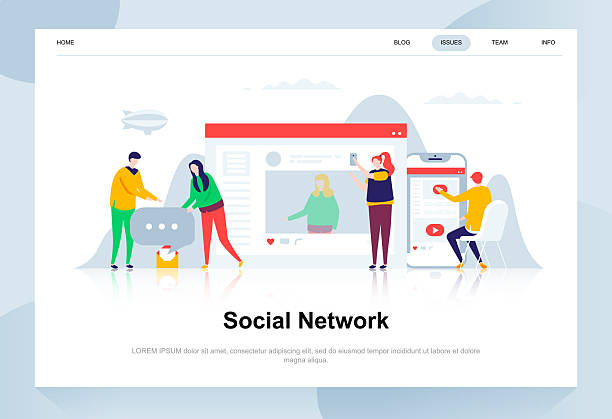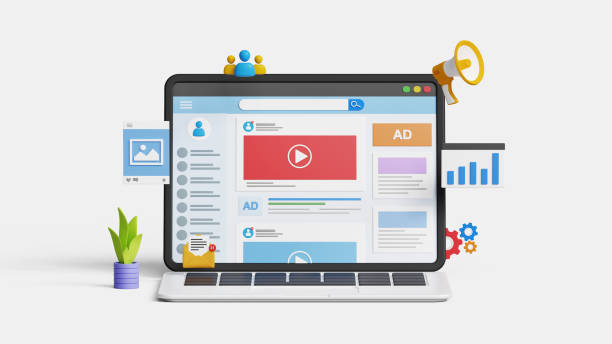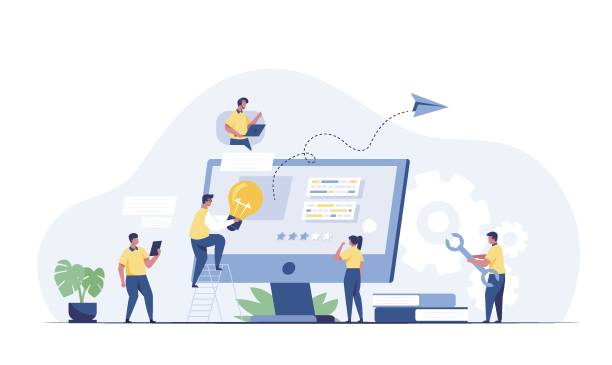Introduction to the Importance of Secure Website Design in the Digital Age

In today’s world, where the physical boundaries of businesses have disappeared due to the internet, a website is not just a marketing tool, but the backbone of any organization’s digital presence.
Therefore, #CyberSecurity and #DataProtection have become more important than ever.
Designing a secure website is no longer a luxury option, but a vital necessity for maintaining #UserTrust and preventing financial and reputational losses.
This is an explanatory and educational discussion that helps you identify threats and protect your website against them.
Did you know that even a small security flaw can lead to a complete loss of brand credibility? This thought-provoking question highlights the importance of a proactive approach to security.
The purpose of this article is to provide a comprehensive and analytical guide for a deeper understanding of web security principles and their effective implementation, so that your website is not only beautiful and efficient, but also robust against cyberattacks.
Failure to address this issue can lead to irreparable consequences, including theft of customer information, service outages, and heavy legal penalties.
Are you worried that your company’s old website is driving away new customers? Rasawap solves this problem with modern and efficient corporate website design.
✅ Increases your brand’s credibility.
✅ Helps attract targeted customers.
⚡ Contact Rasawap for a free consultation!
Common Threats and Website Vulnerabilities

Before delving into secure website design solutions, it’s essential to become familiar with #CyberAttacks and #CommonVulnerabilities.
This specialized and explanatory section helps you gain a better understanding of the hidden enemies of your website.
Attacks such as DDoS (Distributed Denial of Service), SQL Injection, XSS (Cross-Site Scripting), and #Phishing attacks target countless websites daily.
Vulnerabilities can stem from #SoftwareWeaknesses in website code, incorrect server configurations, or even user unawareness.
A concerning news is that the statistics of cyberattacks on websites are steadily increasing, and hackers are using more sophisticated methods.
Understanding these threats is the first step towards securing your website.
Paying attention to these points is vital for securing your site.
Principles and Best Practices in Secure Coding

The foundation of secure website design lies in #SecureCoding.
This guidance and educational section helps developers avoid common mistakes that lead to security vulnerabilities.
The first principle is #UserInputValidation.
Any data received from the user must be carefully checked and sanitized to prevent attacks like SQL Injection and XSS.
Using Prepared Statements and parameterized queries for database interaction is essential.
Also, strong hashing functions should be used for storing passwords, and passwords should never be stored in plain text.
Using secure and up-to-date frameworks can also significantly contribute to website security, as these frameworks usually have built-in security mechanisms.
The table below provides a summary of best practices for secure coding, which are essential for every developer to observe:
| Security Principle | Brief Description | Implementation Example |
|---|---|---|
| Input Validation | Validating and sanitizing all user inputs. | Using filters and escape functions to prevent SQL Injection and XSS. |
| Sensitive Data Encryption | Sensitive information (such as passwords) must be hashed and encrypted. | Using BCRYPT or PBKDF2 for password hashing. |
| Secure Error Handling | System error information should not be displayed to regular users. | Displaying general error messages to the user and logging detailed errors for the admin. |
| Session Management | Proper management of sessions to prevent Hijacking. | Generating strong session tokens, session expiry, and regenerating tokens after login. |
These specialized principles are foundational for developing secure web software and play a key role in designing a secure website.
Database Security and Protection of Sensitive Information

The database is the heart of any website, containing vital user and business information.
Therefore, #DatabaseSecurity is of particular importance.
This is a specialized and guidance section that shows you how to protect this treasure trove of information.
The first step in secure website design from a database perspective is #DataEncryption; especially sensitive information such as credit card numbers or personally identifiable information.
Using encryption tools at the database or application level is essential.
Also, strict #AccessControl to the database is of high importance.
Each user or service should only have access to the minimum information and operations necessary for their task (Principle of Least Privilege).
This includes creating database users with limited roles and permissions.
Regularly maintaining encrypted backups and storing them in a secure, separate location is also vital for data recovery in case of an incident.
These solutions ensure that even if the outer layers of the website are breached, sensitive information in the database remains protected.
Failure to comply with these measures can have catastrophic consequences, including widespread data breaches that can completely destroy a business’s reputation.
Losing potential customers due to an unprofessional corporate website? Rasawap is your answer! With our specialized corporate website design services:
✅ Enhance your brand’s credibility and standing
✅ Experience more targeted customer attraction
⚡ Act now to get a free consultation!
Strong Authentication and Authorization Mechanisms

Authentication and authorization are the main pillars of website security, ensuring that only authorized users have access to specific information and functionalities.
This educational and guidance section helps you correctly implement these mechanisms.
Using #MultiFactorAuthentication (MFA) is a highly effective method for strengthening system login security, because even if a password is compromised, the user account remains protected.
#SessionManagement is also of great importance; session tokens must be sufficiently strong, have an expiration time, and be regenerated after every sensitive operation (such as changing a password).
Implementing #FineGrainedAccessControl (Role-Based Access Control – RBAC) means that users have different access permissions based on their roles.
Have you ever wondered how some websites prevent unauthorized access? These thought-provoking mechanisms are the key.
This approach ensures that no user or attacking system can access data or functionalities they are not authorized to access.
Correct implementation of these mechanisms is a vital part of secure website design.
Using SSL/TLS and Communication Encryption

In today’s world, a website without an SSL/TLS certificate is almost unimaginable.
This technology is the foundation for #DataEncryption between the user’s browser and the website server, preventing eavesdropping, tampering, or forgery of information.
This is an explanatory and specialized section that clarifies the importance of these protocols.
Installing an SSL/TLS certificate and ensuring all website traffic is redirected from HTTP to HTTPS is the first step in website security.
Browsers flag websites without HTTPS as insecure, which severely impacts #UserTrust and the website’s SEO ranking.
#TransportLayerSecurity not only protects sensitive information such as login or payment details but also ensures that the content delivered to the user has not been tampered with.
Using SSL/TLS is a fundamental step towards designing a secure website and creating a trustworthy online environment.
Without this protective layer, any communication between the user and the website is at risk.
The Importance of Regular Security Audits and Updates

The sustainability of secure website design requires a continuous approach, not a one-time action.
This guidance and analytical section addresses the importance of #RegularSecurityAudits and #SoftwareUpdates.
Cyber threats are constantly changing and evolving, so your website must keep pace with them.
Conducting #PenetrationTesting by security professionals can identify unknown vulnerabilities before hackers exploit them.
Regularly updating all website components, from the Content Management System (CMS) and plugins to frameworks and server operating systems, is crucial.
Many cyberattacks exploit known vulnerabilities in outdated software.
Did you know that most security breaches happen due to a lack of simple updates? This is a thought-provoking and yet alarming news that must be taken seriously.
Establishing a regular schedule for reviewing security logs and monitoring website traffic also helps identify suspicious activities.
The table below provides a checklist of key actions for maintaining continuous website security:
| Security Action | Description | Recommended Frequency |
|---|---|---|
| Software Updates | CMS, plugins, themes, frameworks, and operating system. | Upon release of security updates / at least monthly. |
| Penetration Testing | Simulating attacks to find vulnerabilities. | At least once a year / after major changes. |
| Vulnerability Scanning | Using automated tools to identify weaknesses. | Weekly / Monthly. |
| Log Review | Monitoring server and website logs for suspicious activities. | Daily / Weekly. |
These are key actions for maintaining website security in the long term.
Incident Response and Data Recovery

Even with the best secure website design approaches, the possibility of a security incident is not zero.
Therefore, having a comprehensive #IncidentResponsePlan is crucial.
This is a guidance and specialized section that helps you remain calm when facing a crisis.
This plan should include specific steps for incident identification, containment, root cause analysis and system cleanup, and finally #DataRecovery.
#RegularEncryptedBackups of website and database information are the cornerstone of any Disaster Recovery plan.
These backups should be stored in secure locations, separate from the main network.
Practicing various security incident scenarios helps your team respond more effectively in real-time.
Can you imagine your website being down for hours or days? This is a thought-provoking and terrifying scenario that can be prevented with proper planning.
Speed and accuracy in incident response can make the difference between a minor disruption and a major catastrophe.
Implementing these approaches is an inseparable part of site security.
Tired of losing business opportunities due to not having a professional corporate website? Don’t worry anymore! With Rasawap’s corporate website design services:
✅ Your brand’s credibility and professionalism will increase.
✅ You will attract more targeted customers and sales leads.
⚡ Get a free consultation right now to get started!
User Training and Fostering a Cybersecurity Culture

Website security is not limited to code and technology; the #HumanFactor also plays a crucial role.
This educational, entertaining, and guidance section addresses the importance of raising awareness among users and employees about #CyberSecurity.
Many successful attacks occur through social engineering and phishing, where attackers exploit users’ unawareness or carelessness.
Educating users on how to identify phishing emails, the importance of using #StrongAndUniquePasswords, and how to manage personal information can significantly reduce the risk of attacks.
These trainings can be presented in creative and entertaining ways, such as holding interactive workshops or providing engaging video content.
Imagine how much safer the digital world would be if every user were a mini security expert! This thought-provoking idea demonstrates the immense potential of education.
Promoting a cybersecurity culture within an organization means that every individual takes responsibility for security and considers it an integral part of their duties.
This comprehensive approach complements technical measures in secure website design.
Future Trends in Secure Website Design and Upcoming Challenges

The world of cybersecurity is dynamic and constantly changing.
Secure website design must also keep pace with these changes.
This analytical and specialized section examines future trends and upcoming challenges in this field.
The emergence of #AIinSecurity and #MachineLearning can help identify complex attack patterns and automate responses to threats.
#BlockchainAndSecurity also have the potential to create more secure distributed and decentralized systems, especially in authentication and data storage.
With increasing concerns about #DataPrivacy and stricter regulations like GDPR and CCPA, websites must focus more on protecting users’ personal information.
New challenges are also on the horizon, such as threats related to QuantumComputing which could render current encryptions ineffective.
Are you ready for this challenging future? This thought-provoking content highlights the need for continuous readiness and innovation in designing a secure website.
Investing in research and development and staying aware of the latest advancements is essential for maintaining security in an increasingly complex future.
Frequently Asked Questions
| Question | Answer |
|---|---|
| What is secure website design? | Secure website design is a process in which websites are built with security principles in mind to be resistant to cyberattacks and to protect user and business information. |
| Why is secure website design highly important? | To prevent unauthorized access to data, sensitive information leakage, malware attacks, loss of user trust, damage to business reputation, and legal consequences resulting from data breaches. |
| What are the most common website vulnerabilities? | SQL Injection, Cross-Site Scripting (XSS), Cross-Site Request Forgery (CSRF), broken authentication and session management, and exposure of sensitive information. |
| How can SQL Injection attacks be prevented? | By using Prepared Statements with bound parameters (Parameterized Queries), Input Validation, and limiting database access. |
| What are the methods to combat XSS (Cross-Site Scripting) attacks? | User Input Validation, Output Encoding before displaying in HTML, and using Content Security Policy (CSP). |
| What is the role of HTTPS in website security? | HTTPS, using an SSL/TLS certificate, encrypts the communication between the user’s browser and the website server, preventing eavesdropping, tampering, or forging of data. |
| What are the best practices for managing user passwords? | Enforcing strong passwords (a mix of letters, numbers, and symbols), hashing passwords instead of direct storage (with strong algorithms like bcrypt), and enabling Two-Factor Authentication (2FA). |
| What is the importance of User Input Validation? | Input validation prevents malicious or unexpected data from entering the system, which can lead to vulnerabilities such as SQL Injection or XSS. |
| How do security reviews and regular audits affect site security? | These reviews help identify vulnerabilities and security weaknesses early, allowing them to be fixed before they can be exploited. |
| What is the application of Web Application Firewall (WAF) in secure website design? | A WAF acts as a protective layer between the user and the website, analyzing incoming traffic, and identifying and blocking common web attacks like SQL Injection and XSS. |
And other services of RasaWeb Advertising Agency in the field of advertising
Smart Content Strategy: A new service to enhance campaign management through optimizing key pages.
Smart Digital Branding: A combination of creativity and technology to improve SEO ranking through attractive UI design.
Smart Direct Marketing: A specialized service for increasing sales growth based on user experience customization.
Smart Conversion Rate Optimization: A professional solution for increasing website traffic with a focus on marketing automation.
Smart Custom Software: Transform user interaction with precise audience targeting.
And over hundreds of other services in the field of internet advertising, advertising consultation, and organizational solutions
Internet Advertising | Advertising Strategy | Advertorial
Resources
- Online Business Website Security: Solutions and Key Tips
- How to design a secure and professional website for your business?
- The Importance of SSL Certificates in Website and Online Business Security
- Effective solutions for protecting your site against cyberattacks
? RasaWeb Afarin Digital Marketing Agency, your strategic partner on the path to online brilliance! With services such as professional SEO, social media management, and multilingual website design, we guarantee a powerful and influential presence for your business. Contact us today and build your business’s digital future.
📍 Tehran, Mirdamad Street, next to Bank Markazi, Southern Kazeroon Alley, Ramin Alley, No. 6

